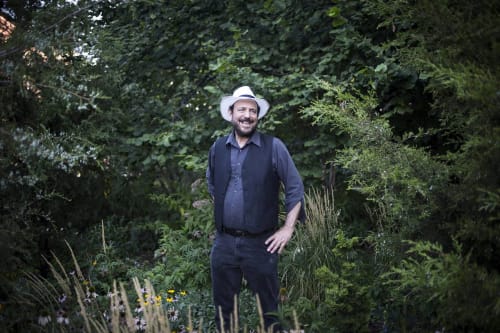Alan Sonfist (b.1946, New York), is a seminal figure among the pioneers of Land Art and environmental art. From an early age, he developed an almost symbiotic relationship with nature, nourished by hours spent in the hemlock grove next to his childhood neighborhood. This woodland, threatened by urban expansion, left an indelible mark on him. Perceived as a repository of collective memory, this forest awakens an acute awareness of the fragility of natural ecosystems in the face of anthropogenic forces. This foundational experience shaped his biohistorical artistic practice, which blends research with creation.
Sonfist's poetry is committed, discreet and unobtrusive, sacrificing nothing to his desire for formal experimentation. Rather than to dominate nature, he sets out to resuscitate it, to restore its original vitality and richness. His most emblematic work, Time Landscape, conceived in 1965 and ultimately completed in 1978 in Manhattan is the perfect illustration of this quest. With this living installation, Sonfist recreates a fragment of New York's pre-colonial forest, reintroducing native plant species to the heart of the metropolis. This confrontation between the biological world and the urban environment opens up a critical reflection on the transformation of age-old landscapes under the impact of colonization and urbanization.
Far from limiting himself to the lands where he was born, Sonfist deploys his artistic and didactic approach on an international scale. His works such as the Lost Falcon of Westphalia in Germany or the Ancient Olive Grove of Athena in Florence, explore the endemic and cultural memory of places - reintroducing extinct or displaced species. Employing the techniques and methodologies of a naturalist, historian, and urban planner, Sonfist collaborates closely with scientists, politicians, and private patrons.
Sonfist's reflection on the temporal stratification of landscapes, ecological resilience and man's relationship with his environment is also expressed in smaller-scale works: paintings, collages, drawings and sculptures. Beyond his plastic work, the artist is distinguished by a rich and abundant body of theoretical thought deeply in tune with the concerns of his time. Beginning in the 1960s, he authored a visionary manifesto, which includes the following excerpts: “Especially within the city, public monuments should recapture and revitalize the history of the natural environment at that location. As in war monuments, that record of life and death of soldiers, the life and death of natural phenomena such as rivers, springs, and natural outcroppings needs to be remembered.”
Sonfist's art has been exhibited in prestigious institutions worldwide such as Dokumenta VI (1977), the Whitney Museum of American Art (1975), the Museum of Modern Art in New York (1978), and the Osaka World Expo (1988). Known for his commissions of natural and cultural landscapes, he notably created Time Landscape in Greenwich Village (1965), Hemlock Forest in the Bronx (1978), the Geological Timeline in Duisburg, Germany (1986), and the Rising Earth Washington Monument in Washington, D.C. (1990).

